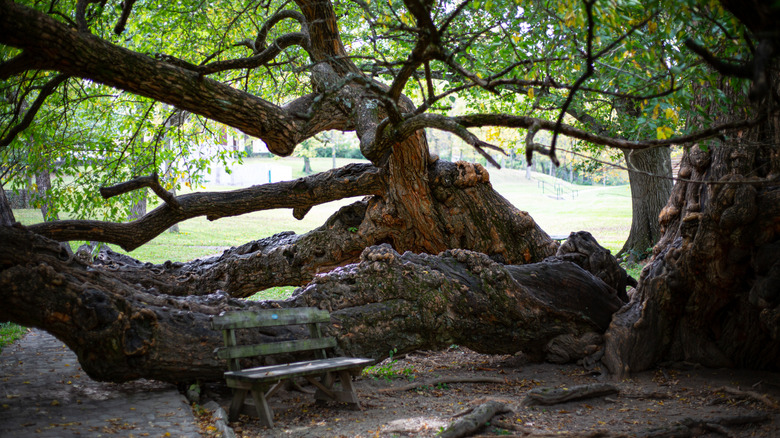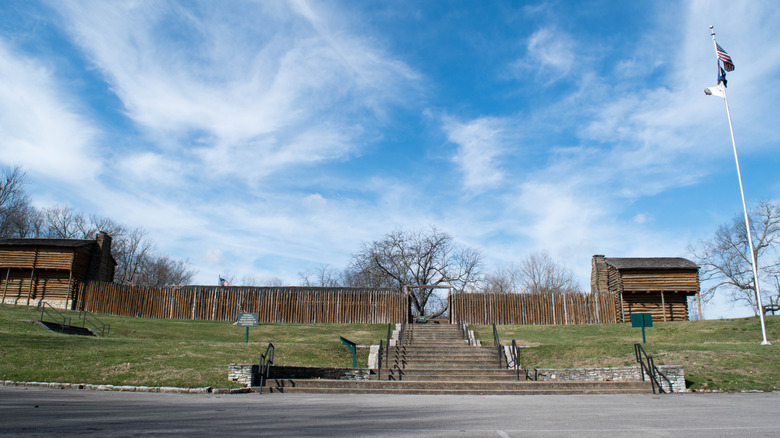The Nation's 'Unofficial' Largest Osage Orange Tree Is In A State Park Marking Kentucky's First Settlement
In Kentucky, you'll find state parks that capture a vast spectrum of history. While at one of its most unique state parks, Big Bone Lick, you can hike and camp among prehistoric animal bones, another showcases relics from the human side of history with a reconstructed pioneer settlement. Old Fort Harrod State Park is at the site of the first sustained pioneer settlement west of the Allegheny Mountains. The fort's long-term settlement began in 1775, when it was set up as a frontier town called Harrodstown. A scale replica of the town exists there today, where you can visit an original 19th-century mansion, see early American artifacts, and wander the oldest cemetery in Kentucky. Within the park's grounds is also one of its oldest gnarled residents: an Osage orange tree that's been around since about the time the fort was settled. A plaque at the tree calls it the "Unofficial National Champion" as the country's largest of its kind (the thing holding it back from the official title is its split trunk).
The park is named after James Harrod, who led the original group of settlers to the site in 1774. At the time, a small fort was built but soon left behind when Dunmore's War began. Harrod returned in 1775 with settlers to establish the permanent town, right around the start of another war — the American Revolution — when Kentucky was the site of violent conflict between settlers and British-backed Native Americans. After the war, the fort served a few different purposes, including being used as a school and a jail. It was eventually neglected, and the state park and fort replica were established to honor its history in 1927.
What to know before visiting Old Fort Harrod State Park
You can reach Old Fort Harrod State Park in about 40 minutes by car from the Blue Grass Airport in Lexington, Kentucky, a Southern foodie city full of friendly charm. There's a fee to enter the fort, though other parts of the 15-acre park — including the cemetery and Lincoln Marriage Temple — are free to visit. Inside the wooden palisades of the reconstructed fort, you can see what life in the pioneer community was like in the 1700s. The cabins and blockhouses in the fort have period-accurate tools and furniture. Regular reenactments take place at the fort, depicting activities that took place in pioneer life, like soap-making and blacksmithing. There's also an annual Fort Harrod Settlement & Raid reenactment in June that demonstrates an attack on the fort. At the Mansion Museum, a preserved building originally constructed in 1813, you can see a range of artifacts that include wartime weapons and some dating back to the 15th century.
Outside of the fort is Kentucky's oldest cemetery, called the Pioneer Graveyard. It was established when the fort was first permanently settled in 1775 and holds graves of the original pioneers. Then, stop by the Lincoln Marriage Temple, which is a curious structural nesting doll: a brick church that contains the log cabin where Abraham Lincoln's parents were married. Near the park's entrance, make sure to take some photos with the legendary Osage orange tree. The tree is 76 feet high, making it markedly larger than the official National Champion in Virginia, which stands 65 feet high. After visiting the park, explore some more historical sites in the surrounding town of Harrodsburg, Kentucky's oldest city in the picture-perfect Bluegrass Region.

